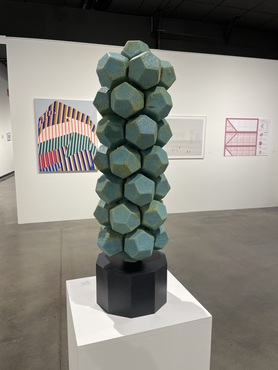
News . Feature Stories . CIA faculty turn time away into time well spent
News
March 20, 2023
CIA faculty turn time away into time well spent

CIA faculty member Barry Underwood created “Borderline” during his summer residency at the Lucid Arts Foundation in Inverness, Calif. Courtesy of the artist.
By Carlo Wolff
Faculty who want to get the best from their break in teaching can do well to keep a few tips in mind. First, welcome new ideas and environments. Second, apply a strong work ethic so no time is wasted.
So say ceramics artist Seth Nagelberg, associate professor of Craft + Design at CIA, and Barry Underwood, chair of Photography + Video.
Nagelberg took his first sabbatical in Spring 2022 semester. He worked at home, traveled to various art sites and gatherings, familiarized himself with other cities, and taught ceramics as a visiting artist at the University of Akron in Akron, Ohio. He also took a 3D printing class through CIA Continuing Education and bought a 3D printer for his studio.
In leaving “room for the unknown,” as he put it, Nagelberg’s technological acumen expanded and his viewpoint changed.
“For years, I preferred the man-made—architecture, machines, toys,” he says. “Now I am seeking the connection between nature and mathematics. Crystals, bubbles and branches can all be explained with geometry and numerals. I learned that my practice can inform my practice. Being immersed has allowed me to form connections between the various things I do.”
What advice does he have for CIA alumni considering a sabbatical?
“Make a plan that includes time to get off-track,” Nagelberg says. “Don’t expect that you will have amassed so much work at the end but that you will have ideas to propel you into the future.”
Where Nagelberg navigated all things urban, Underwood positioned himself in the natural. He spent his 11th residency during summer 2022 at the Lucid Arts Foundation in Inverness, Calif. During his three weeks there, he made sure to create new work, but he also had time to simply think.
“Being alone on a hillside with a fox, deer and some quail allowed plenty of self-reflection,” says Underwood. “It is a privilege to be given an environment to work in, a studio to work out of and do prep work, and the time to do the work.”
Underwood pursues residencies in places that highlight nature. The weather and solitude rekindle his empathy for his students.
“Every time I begin a new residency, I think of how this is a similar experience that the students might be going through when they arrive,” he says. “As an artist, you need to keep learning something, be it technical skills or tools, new concepts, or something happening in society.”
Search for residency opportunities in environments you want to experience, he advises. Avoid residencies that charge a fee and don’t expect miraculous transformations.
“Being an artist is a job,” Underwood says. “There are no magical experiences. You go to whatever your studio is and make something.
Art is about “making and trying and failing and trying again and again, along with being open and exposed to various types of culture. Pieces and ideas connect. Then you go to bed, get up the next day, and try it again.”
Latest Headlines view all
-
April 24, 2024
Cleveland Institute of Art welcomes alum Omari Souza as 2024 Commencement speaker -
April 02, 2024
Cleveland Institute of Art students partner with Progressive Art Collection to exhibit Ready, Set, Relay! -
March 04, 2024
Cleveland Institute of Art announces Curlee Raven Holton Inclusion Scholar Program
Questions?
For more information about this or other CIA news, contact us here.

Social Feed